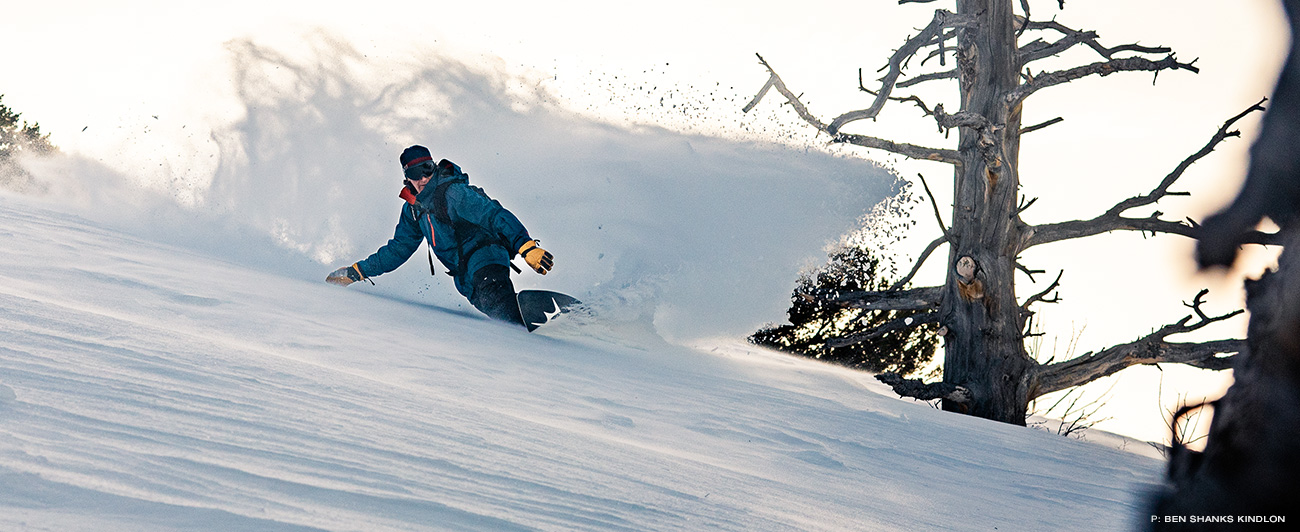Yodel
Organic Intelligence
Generations of Appreciation
First published in Volume 21, Issue 1 of The Snowboarder’s Journal
The cat purrs as it steadily climbs the mountain. The snowcat is roaring its way up Powder Mountain, UT, to be more specific. I’m sitting in the back of it with an eclectic crew of a dozen or so snowboarders spanning several different disciplines and approaches to riding. Notably, we also span generations.
First, we’ve got Tom Burt, a legendary freerider from Lake Tahoe, CA. Revered as one of snowboarding’s great freeride pioneers, Tom was ripping big mountain lines before some of us were even born, making first descents on boards considered clunky and primitive by today’s standards. This morning he’s on a swallowtail reminiscent of boards from those early days of his career, but it’s much better built with contemporary materials and techniques. Technology has come a long way in Tom’s lifetime. His style is surfy yet dialed and after 30-plus years of snowboarding, his eagerness for a fresh turn still speaks for itself.
Then there’s Noah Elliott, a two-time Paralympic medalist with a metal leg and need for speed. Known for being one of the fastest amputees to ever race snowboards, Noah has been competing in banked slaloms since 2017 after he battled cancer into remission and learned to ride on a prosthetic limb. Regardless of his artificial leg, he rips by anyone’s standards. In lively, athletic fashion Noah tears down the fall line before blowing up a big toeside turn, while leaving plenty of snow untouched for the next person to throw a wave of their own.
The rest of our crew consists of photographers, videographers, board builders and other folks who contribute to this snowy sideways-standing culture in one way or another. Later we’ll meet up with a historian of sorts, a guy by the name of Mark “Winkerstick” Winkelaar. Winkerstick tells me a brief history of Winterstick Snowboards, whose 50th birthday we’re celebrating, and about Dimitrije Milovich’s experiments with producing the company’s early prototypes at Powder Mountain in the 1970s. Unsurprisingly, not all of them panned out. But the ideas that stuck added slowly to the technological progression of the sport, which has truly skyrocketed since the days that Jake Burton, Tom Sims, Chuck Barfoot, Ernie DeLost, Dimitrije and others first started tinkering with snowboard designs across the nation.
Every aspect of technology surrounding snowboarding—from the way we strap in to how we stay warm to how we capture and share the experience and more—has advanced in ways that would be unfathomable to our earliest innovators’ younger selves. Would a 1980s Tom Burt believe that one day an amputee could stay hot on his swallowtail as they charged down a mountain with this level of poise and precision? Given the greater scientific know-how, automation and even artificial intelligence currently at play in today’s growing world, there’s just no telling how far tech in snowboarding might evolve. Maybe one day prosthetic limbs will become so advanced that you could ride better with them than you would a pair of organic legs. But that’s a TED Talk for another time.
Looking past technology, there’s a unifying thread that ties us all together. A feeling shared between riders going into their 40th season and those who have only recently become entranced by snowboarding. An aspect of our humanity that connecting to nature and to the now that sliding the snow-caked surface of the Earth unlocks from within each of us. Something intangible that technology can undoubtedly aid us in pursuing but will never be able to fully, artificially re-create.
Looking forward, I take comfort in believing that no matter how far technology evolves, what goes into our boards, or how we depict snowboarding, at the core of it all will be snowboarders reveling in boarding on snow. The driving force. Our enduring delight. An organic, ageless love that, when reduced to its essence, can be oh so simple.
